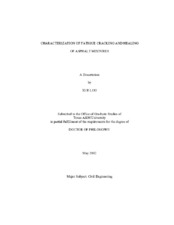| dc.contributor.advisor | Lytton, Robert L. | |
| dc.creator | Luo, Xue | |
| dc.date.accessioned | 2012-07-16T15:58:07Z | |
| dc.date.accessioned | 2012-07-16T20:30:20Z | |
| dc.date.available | 2014-09-16T07:28:20Z | |
| dc.date.created | 2012-05 | |
| dc.date.issued | 2012-07-16 | |
| dc.date.submitted | May 2012 | |
| dc.identifier.uri | https://hdl.handle.net/1969.1/ETD-TAMU-2012-05-10924 | |
| dc.description.abstract | Fatigue cracking is one of the most common distresses of asphalt pavements, whereas healing is a counter process to cracking which alleviates cracking damage and extends fatigue life of asphalt pavements. Most of existing methods to characterize fatigue cracking and healing are generally empirical or phenomenological in nature, which does not satisfy the need to develop mechanistic-based pavement design methods. The objective of this study is to characterize fatigue cracking and healing of asphalt mixtures using an energy-based mechanistic approach.
A controlled-strain repeated direct tension (RDT) test is selected to generate both fatigue cracking and permanent deformation in an asphalt mixture specimen. Fatigue cracking is separated from permanent deformation from a mechanical viewpoint. The development of fatigue cracking is described by the evolution of the damage density and the increase of the average crack size with the increase of loading cycles.
A creep and step-loading recovery (CSR) test is designed to measure the internal stress in the recovery phase of an asphalt mixture specimen. The internal stress and the strain measured in the recovery phase are used to conduct the mechanistic analysis of recovery and healing of the asphalt mixture specimen. Then healing is described using the decrease of the damage density and average crack size with time.
Different types of asphalt mixtures produce distinctly different fatigue cracking and healing characteristics. The effect of mixture composition, temperature, and aging are evaluated using the approach above. The entire series of tests for fatigue, permanent deformation and healing can be completed in one day, with the healing part requiring only a matter of minutes. The methods proposed in this study characterize fatigue cracking and healing of asphalt mixtures using its essential cause and effect relationship. | en |
| dc.format.mimetype | application/pdf | |
| dc.language.iso | en_US | |
| dc.subject | asphalt mixtures | en |
| dc.subject | fatigue | en |
| dc.subject | crack growth | en |
| dc.subject | healing | en |
| dc.subject | recovery | en |
| dc.subject | dissipated pseudo strain energy | en |
| dc.subject | recoverable pseudo strain energy | en |
| dc.subject | dissipated strain energy | en |
| dc.subject | recoverable strain energy | en |
| dc.subject | energy-based mechanistic approach | en |
| dc.subject | true stress | en |
| dc.subject | internal stress | en |
| dc.subject | damage density | en |
| dc.subject | average crack size | en |
| dc.subject | number of cracks | en |
| dc.title | Characterization of Fatigue Cracking and Healing of Asphalt Mixtures | en |
| dc.type | Thesis | en |
| thesis.degree.department | Civil Engineering | en |
| thesis.degree.discipline | Civil Engineering | en |
| thesis.degree.grantor | Texas A&M University | en |
| thesis.degree.name | Doctor of Philosophy | en |
| thesis.degree.level | Doctoral | en |
| dc.contributor.committeeMember | Little, Dallas N. | |
| dc.contributor.committeeMember | Epps Martin, Amy | |
| dc.contributor.committeeMember | Hartwig, Karl T. | |
| dc.contributor.committeeMember | Luo, Rong | |
| dc.type.genre | thesis | en |
| dc.type.material | text | en |
| local.embargo.terms | 2014-07-16 | |


